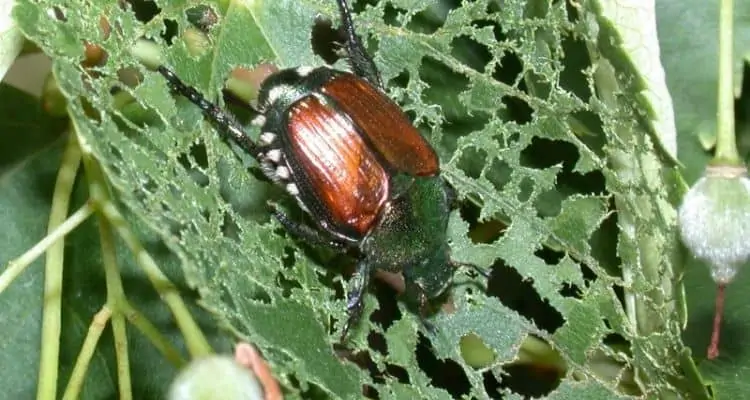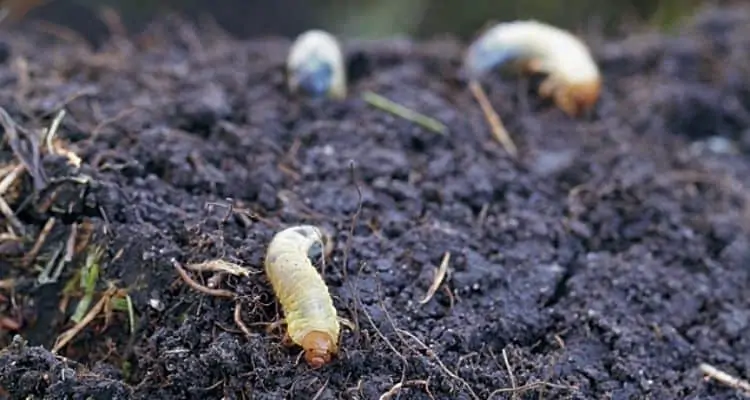Japanese Beetle is one of the biggest nightmares for gardeners. Since 1916 these beetles have become permanent residents of the Eastern Parts of the United State. The name Japanese Beetle comes from their country of origin – Japan. These beetles can feed on almost any green vegetation and leave just the skeleton behind. They are famous to make haunted skeletons structures of green plants. They feed on the green portion and leaves the veins undisturbed.
Check out my Previous post- Pros & Cons of Using Plastic Planters- Garden Facts
Do you Know?- Popillia japonica is the scientific Name of Japanese Beetles.

We, gardeners, use either traps or pesticides to get rid of these nasty beetles. I personally don’t like the use of chemicals. So I prefer the Japanese Beetle traps.
After using these traps from several growing seasons, I wanna make a conclusion. Actually, there were several rumors or myths spreading online about using these JB traps. I just wanna share my honest experience.
Check out these- RESCUE! Japanese & Oriental Beetle Trap
Ok, before proceeding let us talk some history…
How and When did Japanese Beetles come to the United States?
In the early days of the 20th Century, somewhere around 1916, these beetles have invaded the US. These beetles may have hitch-hiked a ride in containers, probably a container full of Ornamental plants. The Import of Ornamental plants and flowers from Japan and other Asian countries was really high even in those days.
A single pregnant Japanese Beetle can lay up to 200 eggs. This chaos may be the result of a single bug traveling from Japan straight to the United States in the early 20th century.
To get completely rid of these devastating Beetles, you should know them perfectly…
Also read- Common Succulent Problem: 6 Pests and their treatment
How to Identify a Japanese Beetle?
There are a few questions to start with, and Identification is probably the first one. You as a gardener must know how to distinguish a Japanese Beetle from other useful beetles.
Japanese Beetles are bluish in color. They have Shiny bronze blade-like wings. The average size of a Japanese beetle is 1/2 inch but this can vary from quarter to one inch. These bugs can be as small as the nail of your pink finger or as big as double the size of your thumbnail. What you find is completely your luck.
Life Cycle of a Japanese Beetle
The life of a Japanese Beetle start as a tiny egg. A beetle can lay more than 200 eggs at once. A larva or grub comes out from each egg within 2-3 weeks.
These grubs dig deep into the soil just after hatching. They start feeding on the root system or anything they can eat. These beetle grubs can stay in the soil for more than 1 year.
Once they get mature, they start forming a pupa. Within few days all the Japanese beetles pop out of the soil. It mostly happens during spring or sometimes in late fall.
They start feeding on every green plant, even flowers and buds are not safe from them. The Japanese beetles are really furious with the plants although their feeding cycle is quite short. They only feed for a couple of months during which they also mate and their life continues.
What is the Impact of the Japanese Beetle Invasion on Garden?
These Beetles are very dangerous to the garden. If there is only one or two of them then, you may not find anything noticeable. Suddenly after few days, you will see several skeleton leaf structures. This will definitely ensure that they are here and you need to act quickly.

They can feed on any plant, flower, fruit, or even veggies. My worst nightmare was to lose more than 3 dozens rosebuds overnight. And trust me it was not a nightmare, I have faced it twice. It was really heartbreaking. Japanese Beetles loves rose buds and flowers. Their attack is always followed by bacterial and fungal attacks on roses.
At first, I was sure that they will not attack hard plants like cactus, banana, or palm, but I was wrong. They can simply feed on any green plant.
| Plants favorite to Japanese Beetle | Plants that Japanese Beetles Dislike |
|
|
This list can go on and on… Suggest some more for my readers.
How to get rid of Japanese Beetles?
There are two specific ways to kill these invasive bugs. First, you can try the natural ways, as the way nature keeps the balance. Next, you can use some techniques or even chemicals if really required.
- Natural Remedy for Japanese Beetles. This includes the introduction of natural predators of these beetles like the Parasitic Wasps.
- Artificial Remedy. It includes two separate techniques. First, you can use a Beetle Trap to lure and capture these bugs. Second, you can try using chemical-based pesticides, especially if the condition is worse than ever.
Can I Introduce Predator Wasp to my garden?– No, you can’t. Even if you know what you are doing, you should not do this on your own.
Actually, this is not legal everywhere in the United States and you may have to face legal actions. Even if it is legal in your locality, you should ask for professional help. This method should be used in a strictly controlled environment or you may witness another bug infestation.
Artificial Remedies for Japanese Beetles
We have already discussed two specific artificial techniques to control Japanese beetles.
- Japanese Beetle Traps
- Chemical Pesticides or Insecticides
How to Use Japanese Beetle Traps?
These bug traps mostly contain three working parts. Actually, they don’t work physically, they just let the bugs work and die collectively.
Parts of Japanese Beetle trap
- Yellow Plate or reflector Surface. They are very much attracted toward the Yellow color.
- A Pheromone Sticker. This sticker container scent or pheromone to attract beetle. This sticker is designed mostly to induce the scent of food and mating, which the beetles can’t resist.
- A collector bag. This plastic bag is used to collect and hold all the bugs inside. Actually, the bag doesn’t kill the bugs. They die on their own due to starvation and exhaustion.
Different brands have different shapes and sizes of these Japanese Beetle traps. Overall these traps are the same in functioning. The quality, durability, and effectiveness may differ with brand and price.
Here are some popular Japanese Beetle traps available on Amazon
How does a Japanese Beetle Trap works? – Once installed, these traps slowly release pheromones to attract Beetles. The pheromones target the food and mating instinct of these beetles.
The smell is strong and irresistible. So They get lured to the trap and fall into the collector bags. Here the Japanese beetle dies on their own or you can just teach them a good lesson.
Common Myth About Japanese Beetle Traps
1# The Traps can Attract Beetles from miles Away.
Nope! This is not true. In fact, a single trap can barely work for 10 feet in the direction of the wind. It is true that Japanese beetles can fly for miles, but these traps cannot attract them for so long. In simple words, This is a myth and clearly busted.
2# Can attract more Beetles than it can catch
Probably, Yes but not always. These traps can really attract lots of Japanese beetles. If the system is not installed correctly or installed close to any flowering plant, then worse can happen.
The smell of the trap cannot hold the Japanese beetles away from roses. So make sure you are not installing these near any flower bed. I have learned this by trial and error. Always place the Japanese beetle traps at least 10 feet away from the target zone. It should be aligned with the wind direction to work perfectly.
3# Beetles can run away from the collector bags
Unfortunately this not a myth, it a truth. Some manufacturers don’t even care for this. They sell collector bags that can’t hold the bugs in them. I know not all of them are bad but there are some that are useless.
Another problem that I actually face is with the drainage hole in collector bags. These holes let the beetles move out easily. What is the purpose of a bag if it has a hole in it big enough to let the bugs out? Still, I use these traps for the easy removal of Japanese beetles
Problems With Pesticides in treating Japanese Beetles
You may think if the traps are not effective 100% then why not use a pesticide. Trust me I also think so, but it was not very useful.
Actually, the pesticide was effective on Japanese beetles but it also eliminates useful bugs like bees and wasps. It is followed by a lack of fertilizing flowers due to fewer pollinators. ultimately 15-20% loss in seasonal production is common on a small garden scale.
Also, the pesticide is harmful to pets and children. So, I generally don’t like taking any health risks for my loved ones.
Using Soap Water to kill Japanese beetles
This is a homemade technique and really effective on a small scale. It can do the job if applied during early days of infesttation. You just need a glass or any container to hold soap and water.
Just check out for every plant and especially the flower buds. If you find any beetle the simply flick it over to the water.
It will drown and die. That’s it. There is nothing to do more. If you love your garden and dedicate some time every day then this should not be difficult for you.

How to treat Japanese Beetle Grubs in Soil
Grubs in soil is another big problem cause by Japanese Bettle. They can feed on roots and kill the plant long before they emerge out as beetles. So isn’t it good to treat them before they turn into a mature Japanese beetle.
Yes, Indeed you should kill them in soil before they can do further damage. To kill the grubs you should be sure if your garden has some.
If your garden has beetle infestation and you found a bare patch in lawn with otherwise green grass. Then this is the alarm. The beetle larva or grub may be the reason behind this.
You can either inspect the soil or just start treating them otherwise.
How to Kill Japanese Beetle larva in soil?
- Water the soil to make it soggy. Most of the larva or grub will drown or come out of the soil.
- Let the soil dry by turning it upside down. Birds, ants and other predators will feed on the bug larva.
- Add some wood ask to make the soil alkaline. This force the bugs to move away, it also prevent any fungal attack on the soil. Lime water is also useful.
- Use chemical pesticide if it is really required.
Final Words
I hope you get the point. Japanese beetle is a furious pest in the garden. It can damage the entire garden really quickly. You can control theinfestation if you act smart in time. Both Traps are Pesticide are effective for controlling Japanese Beetles. I also use soapy-water to kill them manually one by one, as much as I can.
What is your opinion about Japanese Beetles? Write your suggestion below in comment box. Also share these with fellow gardeners. You should also read Why are flowers Brightly Colored?
I’ll be back with another interesting topic till then keep reading Keep Gardening!
